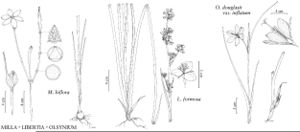Difference between revisions of "Libertia formosa"
Edinburgh New Philos. J. 15: 383. 1833.
IntroducedIllustrated
imported>Volume Importer |
imported>Volume Importer |
||
| Line 55: | Line 55: | ||
|publication year=1833 | |publication year=1833 | ||
|special status=Introduced;Illustrated | |special status=Introduced;Illustrated | ||
| − | |source xml=https:// | + | |source xml=https://bitbucket.org/aafc-mbb/fna-data-curation/src/2e0870ddd59836b60bcf96646a41e87ea5a5943a/coarse_grained_fna_xml/V26/V26_712.xml |
|genus=Libertia | |genus=Libertia | ||
|species=Libertia formosa | |species=Libertia formosa | ||
Latest revision as of 22:16, 5 November 2020
Stems 60–125 cm. Leaf blades linear, 15–45 cm × 5–15 mm. Rhipidia fewer than 10-flowered. Tepals white; outer suberect, flushed greenish or brownish abaxially, lanceolate, less than 10 mm; inner spreading, obovate, 12–18 mm; pedicel 6–12 mm. Capsules round to oblong, ca. 1 mm wide. Seeds ca. 25.
Phenology: Flowering spring.
Habitat: Disturbed, urban, coastal areas
Elevation: 0–50 m
Distribution
Introduced; Calif., South America (Chile).
Discussion
Libertia formosa is cultivated as an ornamental and is an uncommon naturalized escape in California.
Selected References
None.
Lower Taxa
None.
